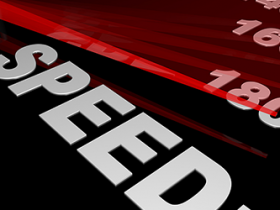Are videos lagging? Downloads taking forever? Do you feel like you’re spending an eternity staring at the buffering wheel of death and screaming “Why is my internet slow”? Then join us in exploring a line-up of the usual suspects behind slow internet speeds. But before we complain too much, let’s take a quick journey down memory lane to see how far we’ve come. Remember the days of dial-up modems, when all you needed for at-home internet access was a computer, landline phone, and a modem? So simple. So … so … slow …
Connecting was often a long, tedious process and the connection could drop at any time. It also tied up your phone line so you couldn’t make and receive voice calls while you were online. (Still, if you’re feeling nostalgic, you’ll love these familiar dial-up beeps). Then along came broadband, with high-speed transmission technologies like DSL, cable, fiber optic and wireless (Wi-Fi), and promised to change the online connectivity game forever. Suddenly, your internet was always on and faster than ever—but how fast is fast and what does internet speed mean exactly?
The speed of your connection is measured in bits and refers to how much time it takes a certain amount of data to transfer from a server to your device and vice versa. Whether you’re attending a Zoom meeting, posting on Twitter, or streaming a series on Netflix, your device is constantly downloading and uploading packets of data. Megabits per second (Mbps), means a million bits of data are transferred every second. When speeds are faster than 1,000 Mbps, we start talking about gigabits per second (Gbps)—or a billion bits per second. Wow.
Let’s see what you can realistically expect from the technology you’re using and why you might not be enjoying the speeds you thought you were signing up for.
The lead role: Your internet service provider (ISP) and the technology they use
This is usually the major factor behind your internet speed because the speed you achieve depends on the type of internet connection. Faster connections generally cost more, so your speed can depend on your budget. Here’s a handy overview of the different types of internet technology. Are you expecting too much from yours?
- Dial-up internet: This plodding dinosaur achieves a top speed of just 0.05 Mbps, so it’s too slow for streaming video. To give you an idea of what that means in practice: A 10-11Mbps connection will take more than five minutes to download one episode of a TV show!
- Satellite: This uses a satellite signal to wirelessly connect to your home. With speeds ranging from 5 Mbps to 25 Mbps, it’s still a relatively slow and expensive option. Also, it has very high latency, which means it takes a long time for the signal to be sent from your computer to the orbiting satellite and back. This makes video chats and online gaming quite disruptive, but there’s an upside: The signal reaches even remote areas! Now, satellite broadband rarely outperforms fiber, but there are new developments planned that could offer a strong alternative eventually. Watch this space…
- DSL: Many standard broadband packages use DSL (digital subscriber line) technology, so it’s quite cost-effective. It’s often widely available too as data is transmitted over an existing telephone network. Speeds tend to range from 0.5 Mbps to 75 Mbps and your speed depends on the distance to your IPS’s central office.
- Cable: Finally! We leave mere megabits behind us and (cautiously) enter the realm of the elusive gigabit. Cable internet uses copper wires and offers beautifully fast speeds of between 25 Mbps and 1 Gbps. It’s not always plain sailing though: Connections are usually shared between multiple homes, so cable networks can get congested during peak hours. Plus, what service providers don’t always tell you, is that the speeds they advertise refer to the download speed only. These are typically much higher than upload speeds. If you’re watching TV, that’s not an issue, but if you’re sharing your own content online (like for video calls), you might be in for a longer wait.
- Fiber: If you’re connected to the web via fiber-optic cables you can be optimistic about enjoying an ultra-fast and highly reliable internet service, with speeds hitting up to 3 Gbps. Fiber can also offer symmetrical upload speeds, which means your uploads are as fast as your downloads. If, however, you live in a rural area, you’ll almost certainly find full fiber isn’t available.
The supporting cast: What else affects your internet speeds?
Location, location, location. And we don’t just mean a fiber-powered post code in central London as opposed to a rural marsh served with satellite. Where you place your router is key. Did you know that Wi-Fi routers transmit both a 2.4 Ghz (gigahertz) and 5 Ghz signal? The 5 GHz network is like a sprinter—it’s faster—while the 2.4 GHz signal has the muscles: It can go through walls and other solid objects like concrete floors that may slow down or even stop a 5 GHz signal. Basically, the more things between your router and your device, the worse your internet will perform. If you’re unlucky enough to be reading this in a concrete dungeon, the page will be loading very slowly indeed (although, admittedly, this might be the least of your concerns).
Technology and solid objects aren’t solely to blame. Humans make a difference too! Your internet speed is shared with every other user in the house and all their devices. So, if you think of your at-home broadband as a cake, how many slices is it being divided into as it serves laptops, phones, tablets, smart TVs, and games consoles? (This may come in handy if you want to hog your own internet connection: See How to Kick Your Kids Off the Wi-Fi). And what about your home itself? Is that a remote-controlled lightbulb sitting sneakily on your Wi-Fi network with its own IP address? Our homes are increasingly ‘smart’, which means they contain internet-enabled appliances from the Internet of Things, and they’re all nibbling away at your internet. That slice of bandwidth “cake” you’re getting, might be leaving your devices very hungry.
And let’s not forget the other silent bandwidth gobblers: The software applications that are constantly checking for and running updates, some of which could be several gigabits in size. Browser add-ons can be culprits too. These programs usually appear on your browser’s toolbar and offer a richer browser experience, but they can also slow you down so beware…Try starting your browser in add-ons disables mode and see if there’s a difference.
Last but certainly not least: Check the health of your computer!
Did you know that one of the most frequent causes of poor Internet performance is malware, especially spyware and viruses? Spyware interferes with your browser and can monopolize your internet connection, slowing it down. Spyware also monitors your keystrokes and tracks what you do online, which adds further delays. With multiple spyware programs running at the same time, you could even lose connectivity altogether!
Now what are viruses possibly doing to your internet connection? When a virus infects a computer, it installs a code which then attempts to multiply itself, usually by sending copies of itself via e‑mail. An infected computer may send hundreds of e‑mails per minute, leaving you with little computing power and bandwidth.
Thankfully, Avira provides a range of free and premium options to help keep your data and devices safer online. Consider Avira Free Security to help block spyware, ransomware, and other online nasties. It also helps secure and anonymize your web browsing with VPN. If you’re prepared to pay a monthly subscription, there’s Avira Prime, which includes premium security, online privacy, and performance features from Avira, plus VIP customer support.
Checked all the above and still not getting what you paid for? Test your connection
ISPs often quote impressive speeds in their ads, but the reality is that not all of us will get the average speeds promised. The “average speed” generally refers to the speed available to least 50% of customers at peak times. That leaves the remaining 50% of us having to contend with slower speeds. Is it time test your internet speed and compare it to what’s been promised by your provider?
There are many speed tests available online. They’re useful options if you want to complain to your ISP about any discrepancy between the mythical figures you were quoted and your daily reality. One quick and easy way is the Ookla Speedtest, which measures the time it takes for data to transfer between your computer and a remote server via your ISP. Use the mobile apps to test your smartphone or download native apps for Windows, Mac, Google Chrome, and even Apple TV. First, it determines your location and pairs you to a local Speedtest server. The whole process should take less than a minute and when it’s done, you’ll be able to view your upload and download speeds. If you create an account, you can view your test history to see how your internet connection has changed over time. Curious to see how you stack up internationally? The Speedtest Global Index lets you compare your speeds with the world.
Netflix loves fast internet connections for obvious reasons and is supporting customers with its own speed test: Fast.com immediately displays your download speeds, but you can also click for more results, including upload speed and latency.
What are your consumer rights regarding internet speeds?
When you buy a broadband package, you enter into an agreement with a provider. The small print varies by provider and country, but generally your chosen ISP must deliver an agreed-upon level of service and if this service is not met (for example, if you’re experiencing slow speeds or interruptions), then they may be in breach of the contract. You might then be able to claim compensation or cancel the contract without incurring a penalty. Some speed bumps are beyond the control of your ISP though—from concrete walls to too many users—so it can be tricky to prove that they’re in breach of providing a satisfactory service. Concrete (sorry. Not walls this time) evidence like measuring your speeds over time and logging the results can help your case, so have the numbers ready and… good luck!
Long story short: Even if your internet service provider claims it can deliver peak speeds of 1 Gbps, or faster, the reality is that you may often receive significantly less. You’ll tend to get the best wireless performance if you’re in the same room as the router, with a household of just a few users. Plus, never forget that the laptop, tablet, or smartphone you’re using must have at least the same capabilities as your router, and not be weighed down with malware and bandwidth munching apps.













